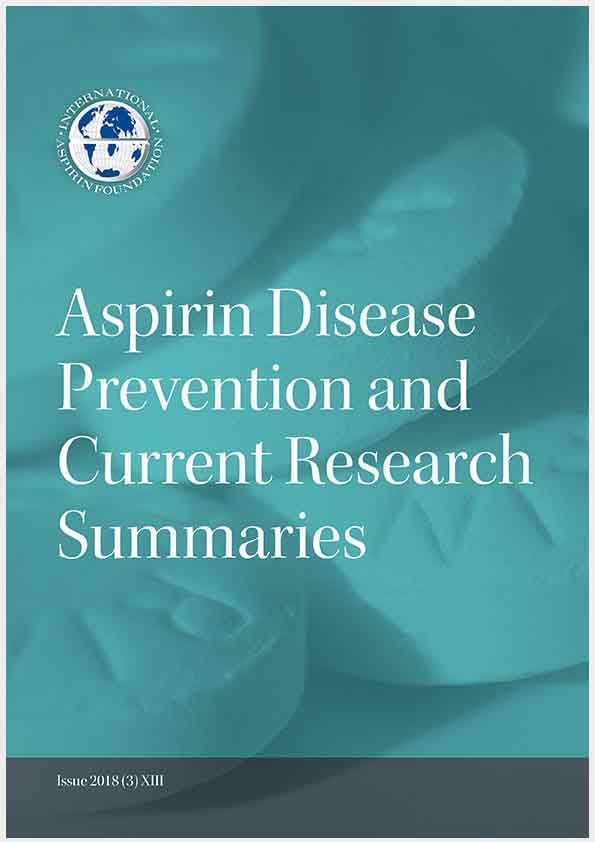New Trial Data
Two of the three recently completed primary prevention trials of low-dose aspirin were presented at the European Society of Cardiology Congress in Munich and simultaneously published online on August 26th.1,2
A Study of Cardiovascular Events in Diabetes2 (ASCEND, funded by the British Heart Foundation) was performed to assess the efficacy and safety of enteric-coated aspirin 100 mg daily, as compared to placebo, in 15,480 adults who had diabetes mellitus without clinically apparent cardiovascular disease. The primary efficacy outcome was the first serious vascular event, i.e., nonfatal myocardial infarction, nonfatal stroke or transient ischaemic attack, or death from any vascular cause (excluding confirmed intracranial hemorrhage). During a mean follow-up of 7.4 years, serious vascular events occurred in a significantly lower percentage of participants in the aspirin group than in the placebo group (658 participants [8.5%] vs. 743 [9.6%]; rate ratio, 0.88; 95% CI, 0.79 to 0.97; P=0.01). In contrast, major bleeding events occurred in 314 participants (4.1%) in the aspirin group, as compared with 245 (3.2%) in the placebo group (rate ratio, 1.29; 95% CI, 1.09 to 1.52; P=0.003), with most of the excess being gastrointestinal bleeding and other extracranial bleeding. In contrast to previous primary prevention trials, there were high rates of use of other preventive strategies with the majority of ASCEND participants taking statins (75%) and blood-pressure lowering drugs. However, near the end of the trial, only about one quarter of participants were receiving proton-pump inhibitors. In such contemporary context, 91 subjects with diabetes would need to be treated to avoid a serious vascular event over a period of 7.4 years, and 112 to cause a major bleeding event. These results are important because:
i) they establish that low-dose aspirin is effective in the prevention of first cardiovascular events in patients with diabetes, when added on top of currently available cardioprotective strategies;
ii) they provide diabetes guideline committees long-overdue, high-quality evidence on the efficacy and safety of low-dose aspirin in this setting to support or revise current treatment recommendations.
The Aspirin to Reduce Risk of Initial Vascular Events study1 (ARRIVE, funded by Bayer) was designed to investigate the efficacy and safety of 100 mg enteric-coated aspirin daily
versus placebo in reducing a composite outcome consisting of time to first occurrence of confirmed myocardial infarction, stroke, cardiovascular death, unstable angina, or transient ischaemic attack, in 12,546 subjects with a moderate estimated risk of a first cardiovascular event. (defined as 10 to 20% 10-year coronary heart disease, with the exclusion of patients with diabetes). Median follow-up was 5 years. In the intention-to-treat analysis, the primary endpoint occurred in 269 (4·3%) patients in the aspirin group versus 281 (4·5%) patients in the placebo group (hazard ratio [HR] 0·96; 95% confidence interval [CI] 0·81–1·13; p=0·6038). Gastrointestinal bleeding events occurred in 61 (1.0%) patients in the aspirin group versus 29 (0.5%) in the placebo group (HR 2·11; 95% CI 1·36–3·28; p=0·0007). When looking at the proportion of the individual components of the primary end-point in the two treatment arms, findings from ARRIVE are generally consistent with previous primary prevention studies that tended to show aspirin’s ability to lower the risk of a first non-fatal myocardial infarction without affecting the risk of total stroke or vascular mortality. However, it should be appreciated that ARRIVE is a largely underpowered study to detect a moderate treatment effect in a low-risk population. In the original sample size calculation, it was estimated that 1488 events would provide 91% power to detect a relative risk reduction of 15%, assuming a placebo event rate of 13.4%. The actually observed rate of vascular events was only about one third of the expected, most likely reflecting the limited predictive power of risk calculators as well as the increasing use and effectiveness of various risk management strategies during the past 10 years.
Neither ASCEND nor ARRIVE reported evidence of a chemopreventive effect of low-dose aspirin against gastrointestinal tract cancer during the scheduled treatment period; long-term follow-up of these secondary outcomes is planned.
The ASPirin in Reducing Events in the Elderly (ASPREE) trial is expected to be reported soon. It can be anticipated that the cardiovascular findings of ARRIVE, ASCEND and ASPREE will be integrated into the existing body of evidence on the efficacy and safety of low-dose aspirin in a primary prevention setting, as summarised by the Antithrombotic Trialists’ collaborative meta-analysis of individual participant data from randomised trials.3
References
1. Gaziano JM, Brotons C, Coppolecchia R, et al. Use of aspirin to reduce risk of initial vascular events in patients at moderate risk of cardiovascular disease (ARRIVE): a randomised, double-blind, placebo-controlled trial. Lancet 2018; published online Aug 26. http://dx.doi.org/10.1016/S0140-6736(18)31924-X.2. The ASCEND Study Collaborative Group. Effects of aspirin for primary prevention in persons with diabetes mellitus. N Engl J Med 2018; published online Aug 26. DOI: 10.1056/NEJMoa1804988.3. ATT Collaboration. Aspirin in the primary and secondary prevention of vascular disease: collaborative meta-analysis of individual participant data from randomised trials. Lancet, 373:1849-1860, 2009.
Does tailoring the dose of aspirin to body weight improve long-term prevention of vascular events and cancer?
By looking at data from 117, 279 participants in ten eligible randomised clinical trials it has been possible to study the impact of body weight on aspirin dose. The aim of this research was to explore whether tailoring the dose of aspirin to a person’s body weight and height may improve outcomes in cardiovascular disease (CVD) prevention. In addition the effect of weight and height on 20 year colorectal cancer or any-in trial cancer prevention was assessed.
The study used data from the Antithrombotic Trialists’ (ATT) Collaboration, other previous systematic reviews of aspirin primary prevention of CVD trials and the Cochrane Collaboration Database of Systematic Reviews.
Interestingly the analysis of this data suggests that a one-dose fits all approach is flawed and low dose aspirin (75-100 mg) was only effective in preventing CVD in patients that weighed less than 70 kg and was not beneficial to the 80% of men and 50% of women weighing 70 kg or more. This was particularly relevant if the person also smoked or if they were using enteric-coated aspirin. The higher doses of aspirin (300-325 mg or 500 mg or more) by contrast were only beneficial in patients weighing 70 kg or more. The reduction of colorectal cancer (CRC) risk from aspirin use also appeared to be dependent on weight. A link between weight
and harm from aspirin was also found with lower weight participants experiencing a higher rate of harm from aspirin use. The risk of sudden cardiac death was also linked to dose and weight.
A tailored weight to dose strategy may, for example, help improve outcomes in women in Japan and parts of Asia where bodyweight is often less than 50 kg. The paper discusses evidence using for a far lower dose of twice daily aspirin in these individuals.
The researchers found that the optimal dose of aspirin for CVD prevention was dependant on body weight and that it was lean body mass and height that was most important for this rather than body mass index. They concluded that a therapeutic window related to body size exists for daily aspirin use for disease prevention and that loss of effect occurs if the dose is too high or low for the body weight. In addition excess dosing for body weight can increase the risk of harm from aspirin.
The potential effectiveness of aspirin for long term CVD and CRC disease prevention could be improved with optimisation of the dose according to body weight. Tailored dosing strategies need to be considered.
For further information please see:
Rothwell PM, Cook NR and Gaziano JM et al Effects of aspirin on risks of vascular events and cancer according to bodyweight and dose: analysis of individual patient data from randomised trials. Lancet 2018: 392:387-99
Aspirin and diet for the reduction of colon cancer risk
Low dose aspirin has been found in multiple randomised clinical trials to protect against colon cancer. Aspirin contains salicylic acid which is also found in fruits and vegetables and phytochemicals such as curcumin, resveratrol and anthocyanins. All these substances inhibit COX a key component in the inflammatory pathway.
The combination of low dose aspirin and phytochemicals could provide a cost effective approach in the prevention of colorectal cancer and further research will be of interest. This paper explores the role of cyclooxygenase-1 and -2 (COX1,COX2) in the inhibition of inflammation and thus suppression of the carcinogenic process.
It considers whether salicylic acid and other salicylates found in fruits and other parts of plants may be useful for cancer prevention. In this way phytochemicals could provide a natural source of anti- COX2 agents for cancer prevention.
Further work is required to understand the role of plant derived salicylates in the suppression of inflammation and prevention of colon cancer.
For further information please see:
Pan P, Huang Y, Oshima K et al. Could aspirin and diets high in fibre act synergistically to reduce the risk of colon cancer in humans? Int J Mol Sci 2018,19, 166; doi:10.3390/ijms19010166.
Low-dose aspirin use in colorectal cancer
This study looked at a population based cohort of 8391 patients with Dukes’ A-C colorectal cancer (CRC) from the Scottish Cancer Registry and linked data in CRC mortality with national prescribing records.
Despite evidence, from previous observational studies indicating an improved CRC- specific survival for patients with CRC taking low-dose aspirin post diagnosis, this study did not find a reduction in cancer- specific mortality in those using aspirin. Many factors may have influenced this result and the authors explore whether lifestyle factors, such as reduced physical activity and obesity, in this Scottish cohort where cardiovascular disease was more prevalent may also have influenced cancer outcomes.
This was an observational cohort study and confounding factors such as incomplete data on comorbidities and compliance with prescribed medication, as well as over the counter use of aspirin in the group not being prescribed aspirin may have affected the results. The follow up was also relatively short with a median of 3.6 years.
The authors state that ” clinical trials assessing adjuvant aspirin therapy in colorectal cancer (NCT02467582; NCT02301286; NCT02301286; NCT00565708; ISRCTN74358648) are keenly anticipated but not due to report until at least 2022.”
For further information please see:
Gray RT, Coleman HG, Hughes C et al Low-dose aspirin use and survival in colorectal cancer: results from a population-based cohort study. BMC Cancer 2018 18:228 https://doi.org/10.1186/s 12885-018-4142-y
Patients taking dual antiplatelets post TIA or ischemic stroke require close monitoring and management in the first 30 days to help reduce the higher early risks of having a major gastrointestinal bleed.
A meta-analysis of 6 randomised clinical trials shows a 2-fold early risk of major gastrointestinal bleeding in the first 30 days of dual antiplatelet treatment that declines over time. Dual antiplatelets are more effective than using single antiplatelet therapy in reducing the early risk of having a recurrent stroke. Close monitoring and the use of gastro protective agents may help reduce this early risk of major bleeding for patients.
Elderly patients (age 65 years and above) had a higher overall risk of having a major bleed but the time course for the early risk of bleeding was similar for patients across the age range.
Whilst successfully reducing the risk of recurrent ischemic events in patients who have experienced a TIA or stroke antiplatelet therapy carries a small but clinically important risk of serious bleeding of approximately 1-1.5% per year. Those who suffer a major bleed have a higher all cause and cardiovascular mortality. Greater understanding and clinical management of these higher risk patients is therefore required.
This study included 48,023 patients who were being treated with antiplatelet therapy following a cerebral ischemia. Data from CAPRIE, CHARISMA, ESPRIT, ESPS-2, MATCH and PRoFESS were included.
The first month of treatment was found to be a higher risk time period for having a major gastrointestinal bleed with a 2 fold increase in this event. The authors suggest this may be due to the fact that those who are at higher risk of having a bleed tend to experience it soon after antiplatelet therapy is commenced. No early extra risk of intracranial bleeding was seen for patients on dual or single antiplatelet medication. This risk of gastrointestinal bleeding decreases after this initial early time frame.
The large sample size and high quality data used in this study provides useful information on the characteristics of bleeding risk for patients managed with antiplatelet therapy in particular dual antiplatelets post TIA or ischemic stroke. This is helpful for ensuring appropriate monitoring and prevention strategies are used in this early higher risk time period.
For further information please see:
Hilkens NA, Algra A, Kappelke J, Barth PM, Csiba L, Rothwell PM et al Early time course of major bleeding on antiplatelet therapy after TIA or Ischemic stroke. Neurology 2018, 90:e1-e7. doi: 10.1212/WNL.0000000000004997
A research team in china works to help plan individualised antiplatelet therapy for patients with coronary artery disease.
Cardiovascular disease (CVD) is a growing health problem in China and a leading cause of death. Information on how to optimise antiplatelet medication for CVD patients in real world settings is urgently needed.
A nationwide antiplatelet cohort of in excess of 20,000 CVD patients has been established with the aim of providing 5 years of clinical follow up. Data on current antiplatelet status, clinical outcomes and predictors of prognosis will be collected.
It is hoped this data can be used to develop thrombotic/bleeding risk scores that will be useful, especially in Chinese CVD patients to help individualise antiplatelet therapy.
In this editorial published in the Chinese Medical Journal Professor Ya-Ling Han describes antiplatelet therapy as the corner stone for the management of coronary artery disease especially with the rise in percutaneous coronary interventions (PCIs). Unfortunately antiplatelet therapy whilst preventing thrombotic events can cause bleeding events.
“Thrombosis and bleeding are two sides of a coin.”
Finding precise ways to understand the multifactorial thrombotic/bleeding risk for individual patients is a key question for research and clinical practice and “we are far from mastering the golden key to treat individual patients precisely.”
Ethinic-specific evidence is important as it seems that risk/benefit ratios may vary between populations. An expert consensus group have reported an “East Asian paradox” where East Asian patients appear at comparable or lower risk of having a thrombotic event but have a greater risk of a bleeding event when compared with Caucasian patients.
Whilst some scoring systems have been developed globally (DAPT, Precise DAPT, PARIS etc.) these are based on patients from clinical trials selected by inclusion/exclusion criteria and will need verification in the real- world environment.
It is hoped that in the future comprehensive global predictors of thrombotic versus bleeding risk for individuals will be designed to help individualise antiplatelet therapy in the clinic for CVD patients. The rapid progression of big data analysis and artificial intelligence will be helpful in providing this. Further research is also needed in special patients subsets and all- comer clinical trials.
Professor Han’s team plan to provide data based on their large cohort of patients that will help in the planning of individualised antiplatelet therapy that will be especially relevant for Chinese CVD patients.
To read editorial please see:
Han YL. Individualized antiplatelet therapy: A long way to go. Chinese Medical Journal 2018 131,12 pp1387-1389












